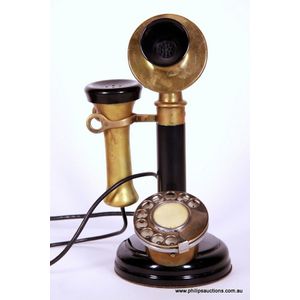Victorian Silver Plate and Ivory Centerpiece
You must be a subscriber, and be logged in to view price and dealer details.
Subscribe Now to view actual auction price for this item
When you subscribe, you have the option of setting the currency in which to display prices to $Au, $US, $NZ or Stg.
- Ivory - Ivory is a hard white material that comes from the tusks of elephants, mammoth, walrus and boar, or from the teeth of hippopotamus and whales. The ivory from the African elephant is the most prized source of ivory. Although the mammoth is extinct, tusks are still being unearthed in Russia and offered for sale.
Ivory has been used since the earliest times as a material for sculpture of small items, both in Europe and the east, principally China and Japan.
In Asia ivory has been carved for netsuke, seals, okimono, card cases, fan supports, animals and other figures and even as carved tusks.
In the last 200 years in Europe ivory has been used to carve figures, for elaborate tankards, snuff boxes, cane handles, embroidery and sewing accessories, in jewellery and as inlay on furniture. Its more practical uses include being used for billiard balls, buttons, and a veneers on the top of piano keys.
The use and trade of elephant ivory have become controversial because they have contributed to Due to the decline in elephant populations because of the trade in ivory, the Asian elephant was placed on Appendix One of the Convention on International Trade in Endangered Species (CITES), in 1975, and in January 1990, the African elephant was similarly listed. Under Appendix One, international trade in Asian or African elephant ivory between member countries is forbidden. Unlike trade in elephant tusks, trade in mammoth tusks is legal.
Since the invention of plastics, there have been many attempts to create an artificial ivory - Registered Design - During the period 1842-1883 the Patent Office issued a diamond mark along with the registration number when a design was registered.
Besides indicating that the design had been registered, a diamond mark offered the buyer the reassurance of knowing an item was of British design. It assured the person registering the design a degree of protection from copying.
The mark was created to identify the type of material used (known as the class), how many items were included, (sometimes known as bundles or packages), and the date of registration.
On the diamond mark the year of registration is shown along with the month code. However, there are two ranges of year codes; 1842-1867 and 1868-1883. By looking at the design of the diamond mark you should be able to determine the correct year from the design of the diamond mark and the placing of the day number.
Source and further information: http://www.nationalarchives.gov.uk/records/research-guides/reg-design-diamond.htm - Victorian Period - The Victorian period of furniture and decorative arts design covers the reign of Queen Victoria from 1837 to 1901. There was not one dominant style of furniture in the Victorian period. Designers used and modified many historical styles such as Gothic, Tudor, Elizabethan, English Rococo, Neoclassical and others, although use of some styles, such as English Rococo and Gothic tended to dominate the furniture manufacture of the period.
The Victorian period was preceded by the Regency and William IV periods, and followed by the Edwardian period, named for Edward VII (1841 ? 1910) who was King of the United Kingdom and the British Dominions and Emperor of India for the brief period from 1901 until his death in 1910.
Visually similar items

Superb Victorian silver plated & ivory centrepiece, by Horace Woodward & Co, Birmingham, comprising of a mirrored tray 69 cm wide beneath an elevated bowl and a pair of tazza, each of temple form with swag and vase fluted pediment and base, each with maker

A single ruby glass vase with lustre drops, etched with grape & vine leaf motif

A brass and Bakelite 'Kellogg' stick telephone, early 20th century. Provenance: The Nec collection, the stick telephone with a separate earpiece and rotary dial, inscribed 'Kellogg' to the mouthpiece with inscribed patent dates from 1901-1907 and 1908 to t

A brass skeleton clock, by 'W Smith, Musselburgh, Maker & Inventor'
